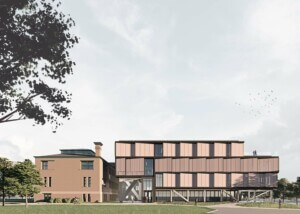Rikers Island, New York City’s notorious jail complex, is set to close within the next decade. For some activists, the pace of change is too slow, but, if the city is taken at its word, ten years is a solid chunk of time to rethink justice in 21st century New York. A design team, convened by Van Alen in collaboration with NADAAA, has set out to do exactly that.
Justice in Design, a new report from the Van Alen Institute, a design advocacy organization, gives broad guidelines on how New York’s criminal justice system should look, feel, and function. Notably, it centers the urban condition but aims to enhance life for those behind bars, as well as those outside the justice system, by elevating both the city and the jail’s livability with public programming, dense service networks, and lots of light and greenery.
The project was deeply collaborative. To produce Justice in Design, Van Alen partnered with City Council Speaker Melissa Mark-Viverito and the legal experts, politicians, developers, and prison reform advocates she convened last year to address the Rikers closure. That group, sometimes called the Lippman Commission but known formally as the Independent Commission on New York City Criminal Justice and Incarceration Reform, issued its recommendations this past March: Closing Rikers Island, it said, is a “moral imperative,” and it advocated for reducing the city’s overall jail population and creating a network of neighborhood-based jails.
To that end, Van Alen convened architects, environmental psychologists, prison reformers, and nonprofit leaders for the project team. Dan Gallagher and Nader Tehrani, principals at New York– and Boston-based NADAAA, partnered with urbanist Karen Kubey; Susan Opotow and Jayne Mooney, a psychologist and associate professor of sociology, respectively, who work at both John Jay College of Criminal Justice and The Graduate Center, CUNY; as well as Susan Gottesfeld of the Osborne Association, a nonprofit that works with justice-involved individuals and their families. (The team is credited in the commission’s report with providing “additional support” to the study.)
The group hosted workshops in the Bronx, Brooklyn and Queens with law enforcement, reformers, academics, and formerly incarcerated individuals to get an idea of what jail is like inside, and after. The workshops, Gallagher said, helped the designers better understand both day-to-day life in Rikers and incarceration’s impact on housing choice, employment, and mental health long after release. From there, the team developed its design guidelines.
Instead of producing a strictly carceral space, the designers envisioned a networked jail system spread throughout the city and meant to serve the wider community, not just prisoners. Called Justice Hubs, the mini-neighborhoods are intended to confront re-entry dilemmas—despite new rules, for example, many industries still discriminate against people with backgrounds—while addressing day-to-day challenges faced by those who work in the criminal justice system.
In the Brooklyn forum, residents said they weren’t concerned about safety if a jail were to open in their neighborhood. Instead, Gahllager said, people were worried the building would be ugly: a grey concrete Hulk surrounded by razor wire. That prompted the team to think not only about the design of the jail itself, but its relationship to the city and its people.
“The building has to become more than a big wall with something else going on inside,” said Gallagher, a partner at NADAAA. “It has to be an active tool of civic engagement.”
NADAAA’s conceptual designs try to make life on the inside as normal (“more conventional,” per Gallagher) as possible. The report emphasizes access to natural light and ventilation not only in outdoor areas, but in visitor rooms, activity spaces, and (especially) cells. Instead of monolithic cinder blocks and concrete finished, the architects advocated for softer, natural finishes to add visual variety and reduce background noise, a significant stressor in close quarters. The layout is supposed to make it easier to move within the jail, and the facilities would be placed near courts and social services. There would be ample but unobtrusive parking for corrections officers, too.
The team didn’t want to reproduce the spatial segregation that Rikers—a literal island in the East River, near Laguardia Airport—embodied. As a result, community facilities like public outdoor space, gardens, art studios, and libraries are part of the program and are open to detainee’s friends and family, as well as residents who have no personal involvement with the jail.
This is the first time NADAAA has done a project like this. Van Alen approached the firm both for their design sense and for their ability to analyze and rethink troubled systems. “It was one of those situations where we said, ‘okay let’s jump in with both feet,'” Gallagher explained. He gave full credit to the team’s non-architects, whose research and work experience brought a local and highly international perspective to the project. They read up on Denmark, for example, which lets inmates wear street clothing and cook with sharp knives (but even their relatively progressive prison system is far from perfect).
The design team’s role going forward is unclear, Gallagher and Van Alen confirmed, but both parties want to stay involved. The general recommendations, summarized on the last few pages of the report, are just that. The concepts don’t specify designs, as Justice Hubs will adjust to local zoning: A 200-bed facility in densely developed Downtown Brooklyn might look very different from a similar-sized jail in St. George, Staten Island. With a mandate to envision a system that at its core features many jails, there wasn’t much room for questioning the fundamentals of the carceral state or challenging the culture of surveillance. But the guidelines are a cautious step in the right direction to end a traumatic system where detainees suffer degrading and abusive treatment, visitors lose hours on the bus to see family, and guards are hurt by inmates who themselves may struggle with poor mental health.
Although Mayor Bill de Blasio supports the closing of Rikers, he hasn’t been totally clear on whether he supports community-based jails. Given how quickly NIMBYs mobilized against the mayor’s new homeless shelters, it’s unclear how residents may react to neighborhood jails. Still, the design team is optimistic about the recommendations. “As a society we have a responsibility to facilitate best outcomes,” said David van der Leer, Van Alen’s executive director. And architects, he hopes, will keep a seat at the table.










